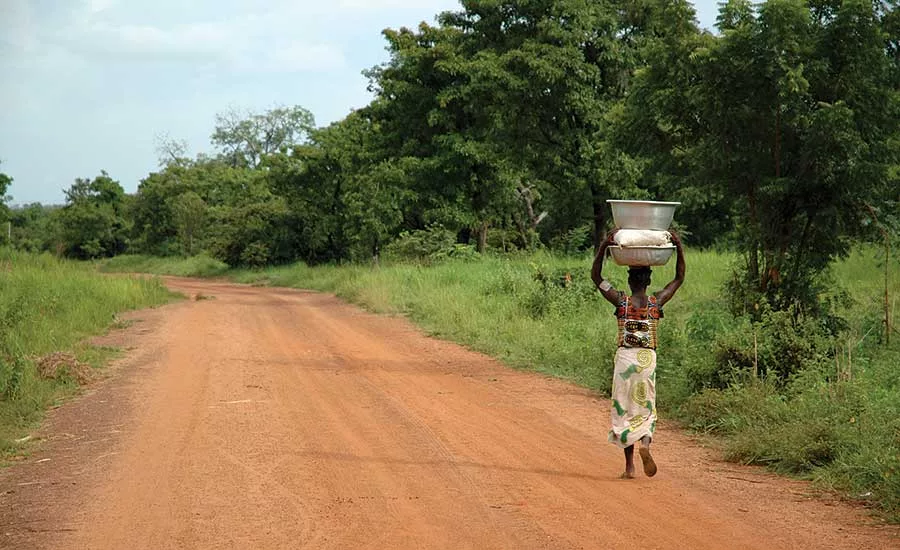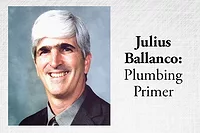Not everybody has access to clean water and indoor plumbing

Imagine getting up every morning and wondering where you were going to get water for the day. That is extremely hard to comprehend in our country, since we start our day by walking into the bathroom and turning on the lavatory faucet. Imagine no faucet — imagine no lavatory!
Water in the U.S. is a cheap commodity that we take for granted. That is not the case in many parts of the world.
My first day in Ghana. I immediately noticed women carrying water on their heads. Children also carried water on their heads. The women had 5-gallon buckets of water that they carried. If you did the math, that equates to about 40 pounds of water that they are carrying, on their heads. Not only can they balance the water on their head, they don’t spill a drop.
You may be asking, “Where are the men?”
In the Kwahu South section of Ghana, the men leave early in the morning for their jobs. Many are fishermen, others are farmers and still others are merchants. They don’t have time to help with the water. So the job of fetching the water is left to the women and children.
Anidaso Health had their seventh medical mission to Ghana in 2016. I accompanied the team as the only plumbing professional. Most of the other team members were associated with the medical profession. There were five doctors, including two surgeons, one anesthesiologist and two internists.
Over the course of two weeks, the two surgeons would perform 60 operations. When you stop to think about it, that is an incredible number of operations, considering one of the surgeons could only stay for a week. The type of operations performed were hernia repairs, thyroidectomies, skin grafts, bowel obstructions, and toe amputations.
The internists traveled each day to the remote villages to provide medical attention to the local villagers. During the two weeks in Ghana, the doctors treated more than 800 villagers. Another amazing number! The doctors and their team, which were nicknamed the “village people,” worked from morning to night with a short break for lunch. The villagers lined up and waited, sometimes for hours, in heat that reached 110° F.
As the plumbing professional on the team, I had three jobs during the two-week medical mission. The first job was rather easy. I had to assist the “village people” doctors and develop a plan to make them more efficient. Imagine being on a construction project and there is no foreman. People are doing their work but nothing is being coordinated. Efficiency drops, as does the profit for the job.
The doctors needed someone to assist in making their job of seeing villagers more efficient. If a doctor is sitting around waiting for the next patient to examine, they are reducing the number of villagers that they can see in a day. If they are dispensing drugs, yet they cannot find the drugs, they are again inefficient.
The next two jobs I was given were a little more difficult. One was to analyze the water and sanitary conditions for the Kwahu South region. The other was to help the plumbing school develop another new plumbing school in one of the remote villages.
I visited a number of the well sites and the new water-treatment facility. I also went to the construction site of the new village-central toilet facilities.
I received help from Kohler regarding the clean-water issues. As my doctor friends point out, the majority of the cases they deal with in the remote villages relate to poor water quality and poor sanitation. Kohler developed a low-cost water-treatment device called Clarity. If you pour water in the top of the device, it filters the water, making it drinkable in the lower section. Clarity can treat enough water a day to satisfy the demands for a family of four.
While it would have been nice to hand out thousands of Kohler Clarity devices, the demonstration was meant to educate villagers and promote the concept of filtering water before drinking the water.
In one of the most remote villages, I inspected the well with one of the doctors before they started seeing patients. The well was a dug well about 40 feet deep. Our visit was at the end of the dry season. The rains would begin in two to three weeks. As we looked at the bottom of the well, it was empty. The well only functioned during the rainy season. However, there were a few puddles on the bottom of the well.
I was speaking to my doctor colleague about the well when we saw a young boy walk up to the well. He threw a plastic bucket on a rope into the well. He managed to get some water from one of the puddles and pulled the bucket back up from the well. Then he leaned back and poured what water he found into his mouth and had a drink. My doctor colleague simply said, “See — that is what I mean about educating the masses about the need to drink clean water. You saw the quality of water at the bottom of that well.”
A new water-treatment plant was located on the edge of Lake Volta. The treatment plant was state-of-the-art. While inspecting the facility with one of the plant superintendents, I received the lowdown on the size and capabilities of the plant.
The water treatment plant served 20 villages. The plant has the capacity to treat 1 million gallons of water a day. However, the plant was currently only operating at 350,000 gallons a day. I commented that the capacity seemed small for serving 20 villages. However, I had to remember that only 10 percent of the population had connections to the water supply with indoor plumbing. When I mentioned that the treatment plant in Chicago treats over a billion gallons of water a day, the superintendent was shocked. He could not fathom that amount of water.
This fall, I’ll return to Ghana and the 1950-era tools they use in the plumbing trade there. In the meantime, thank your lucky stars that we have high-quality water readily available throughout our country.
Making a difference
Anidaso Health will conduct their eighth medical mission to Ghana in February 2018. I will once again join the team. Major sponsors of Anidaso Health are the International Association of Plumbing and Mechanical Officials (IAPMO) and Franciscan Alliance. All the money donated goes to medical supplies and other supplies for the people of Ghana. All the team members pay their own way. I wrote a book, which is basically my daily log, about the last Ghana mission. I cleverly titled the book, “My Ghana Experience.”
If you would more information about the book and how to donate to Anidaso Health, please email me at jbengineer@aol.com.
This article was originally titled “Life in Ghana: The search for water” in the October 2017 print edition of Plumbing & Mechanical.
Looking for a reprint of this article?
From high-res PDFs to custom plaques, order your copy today!






